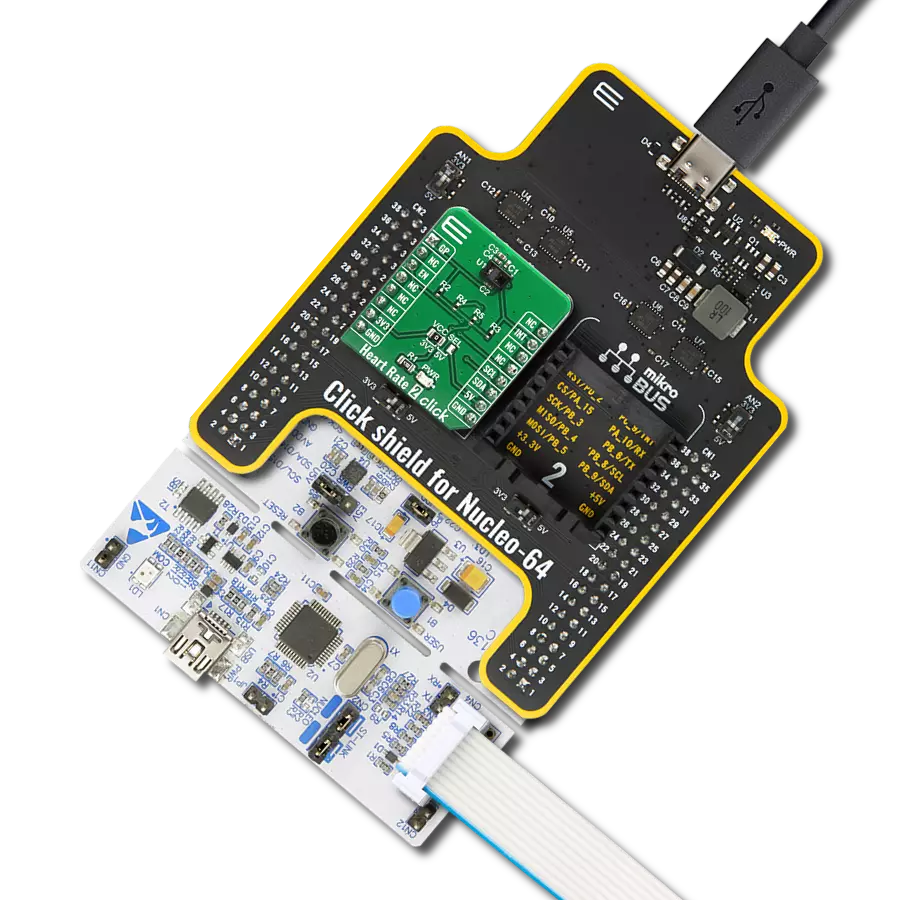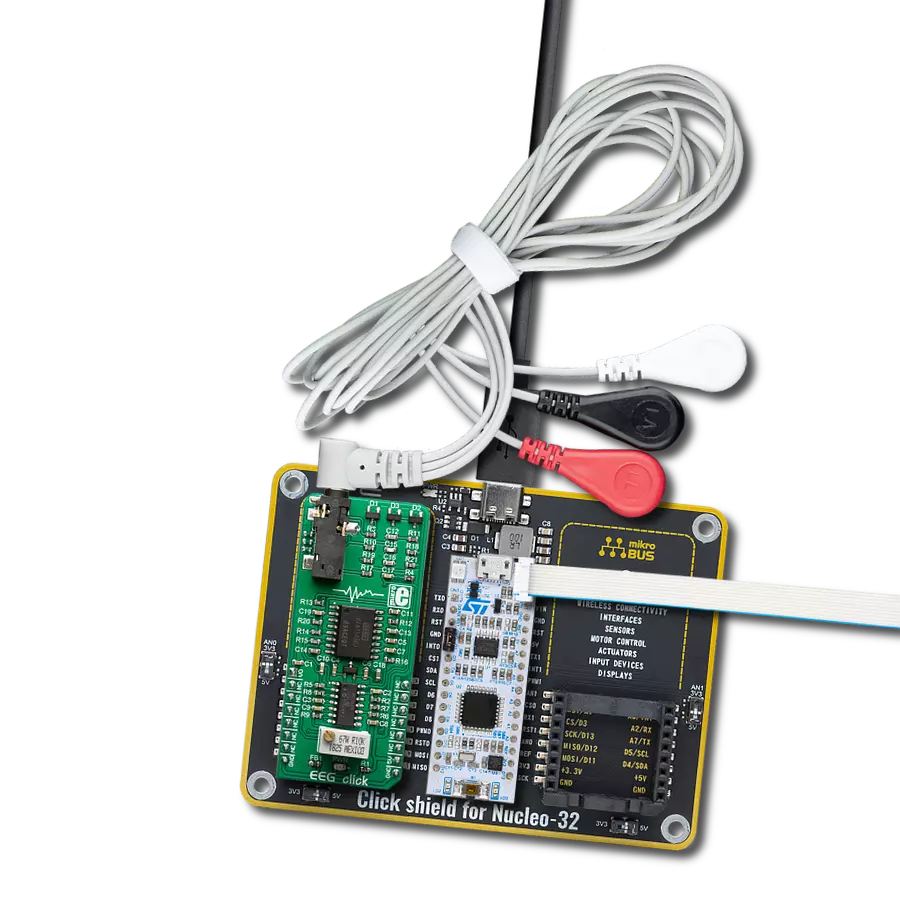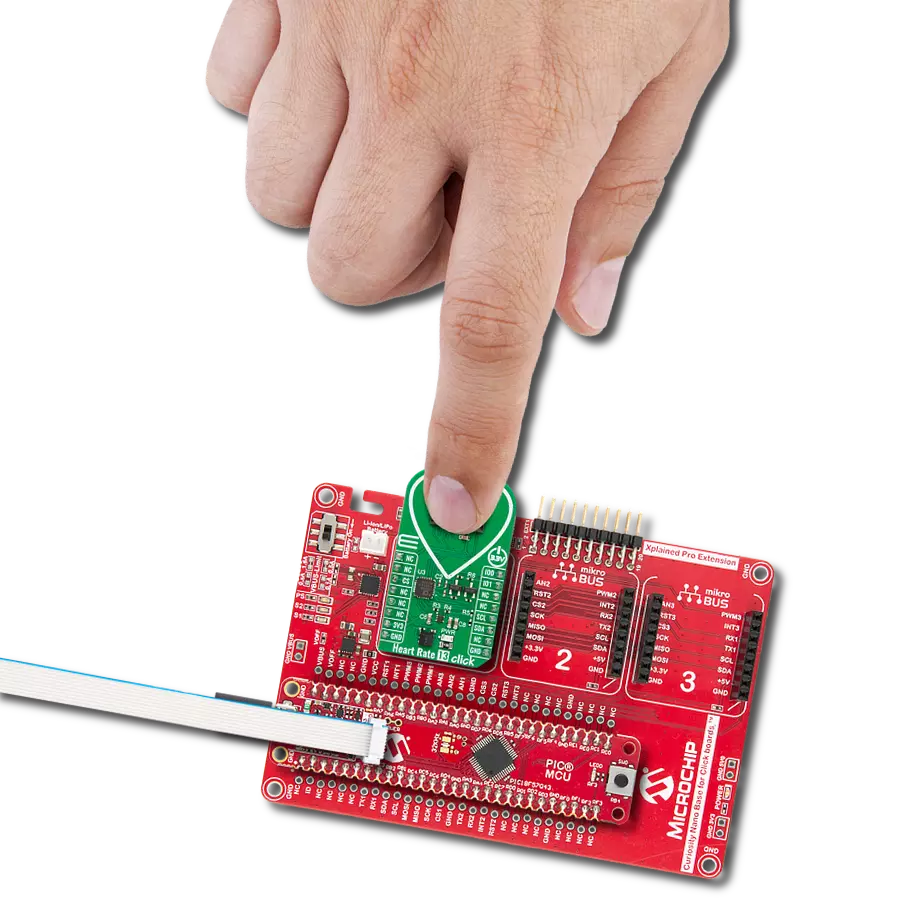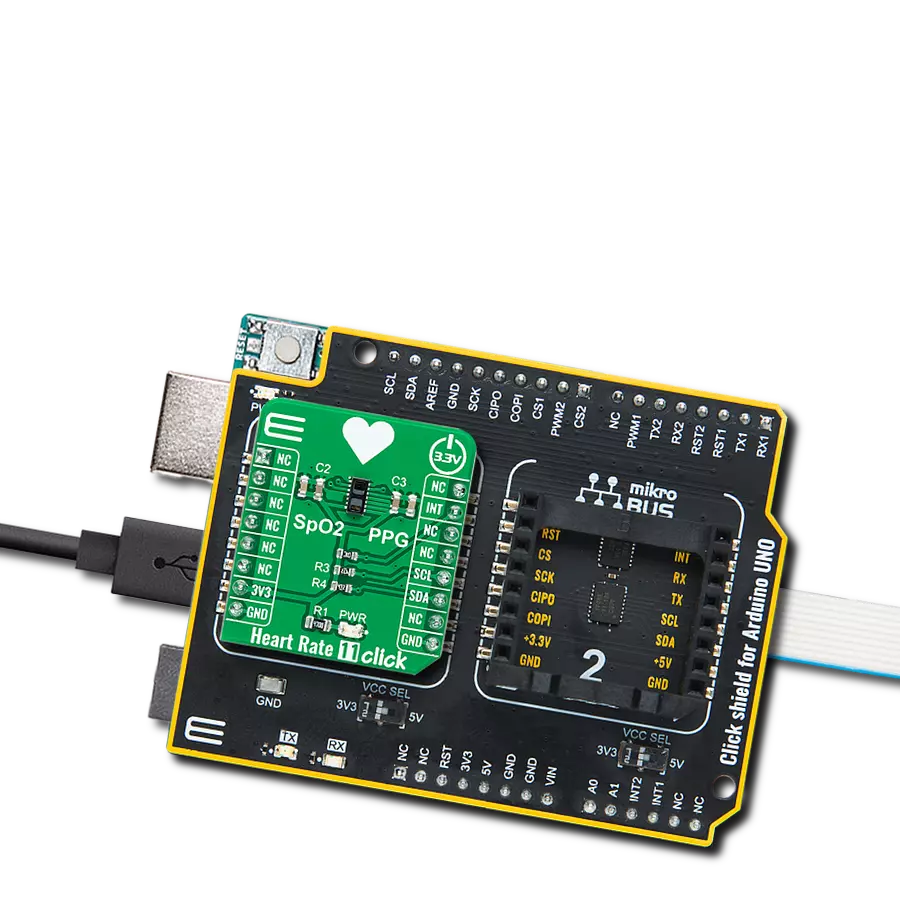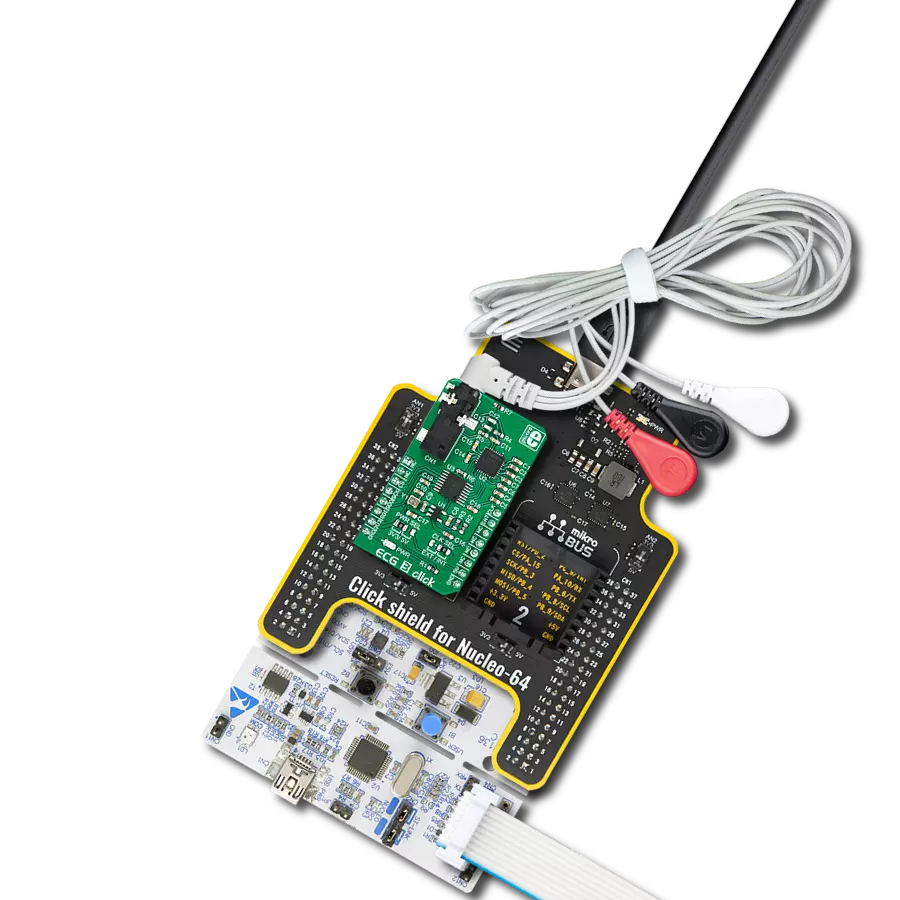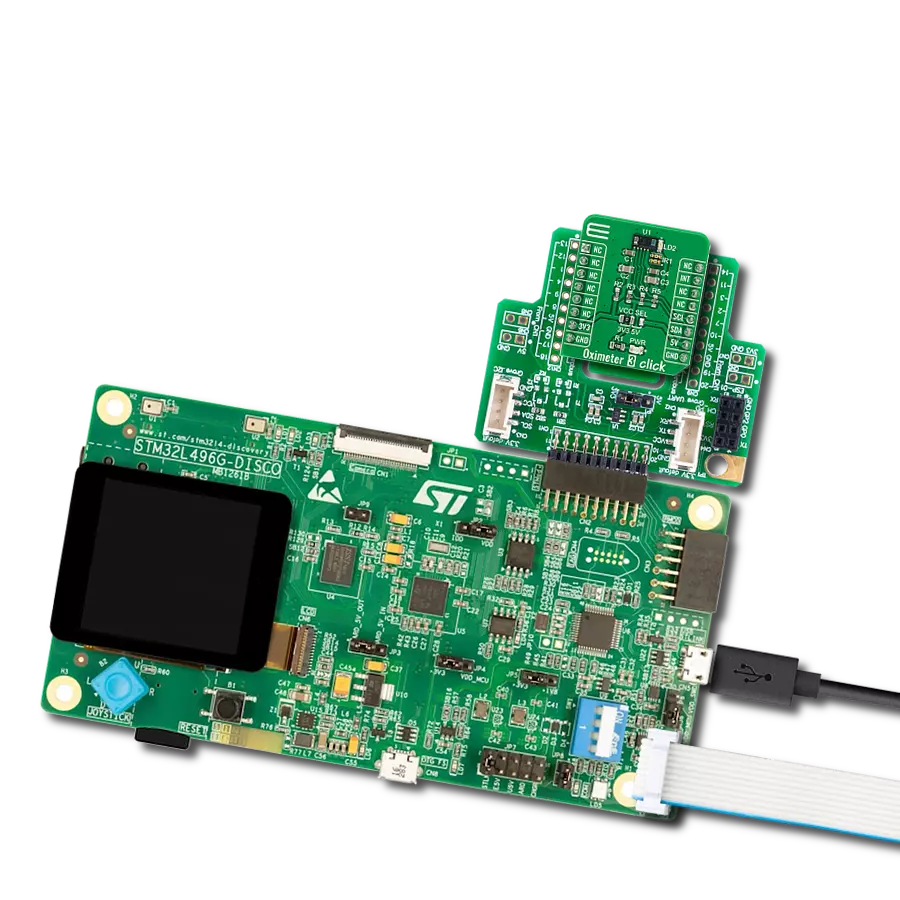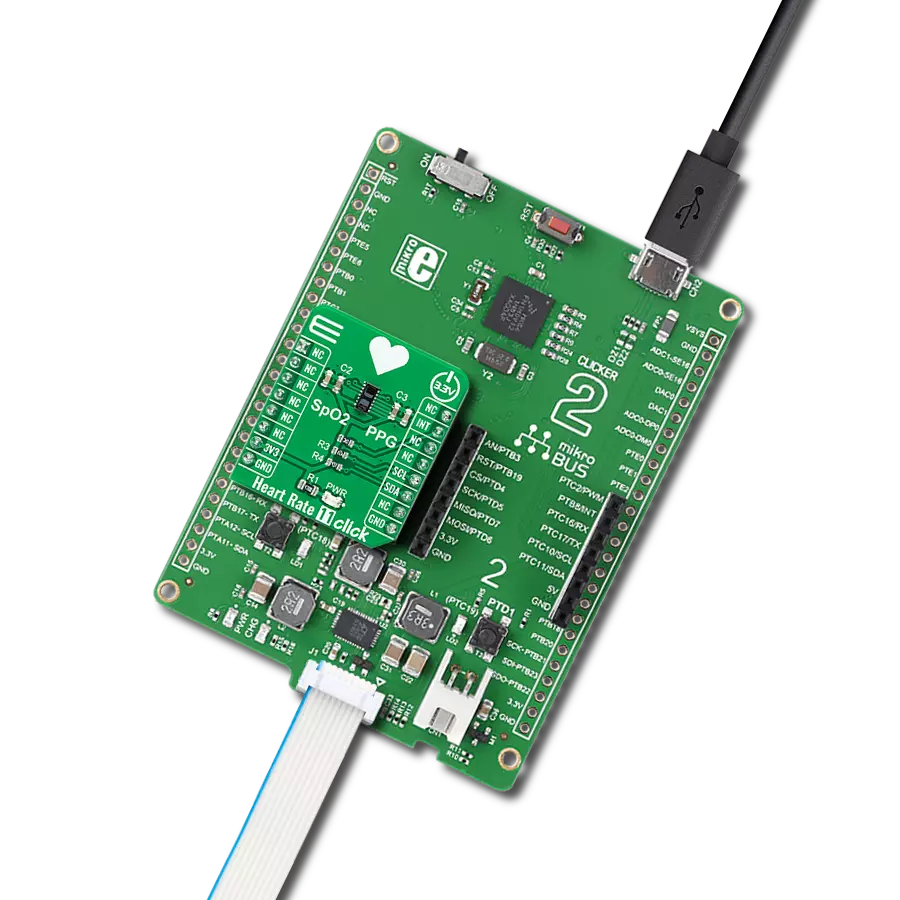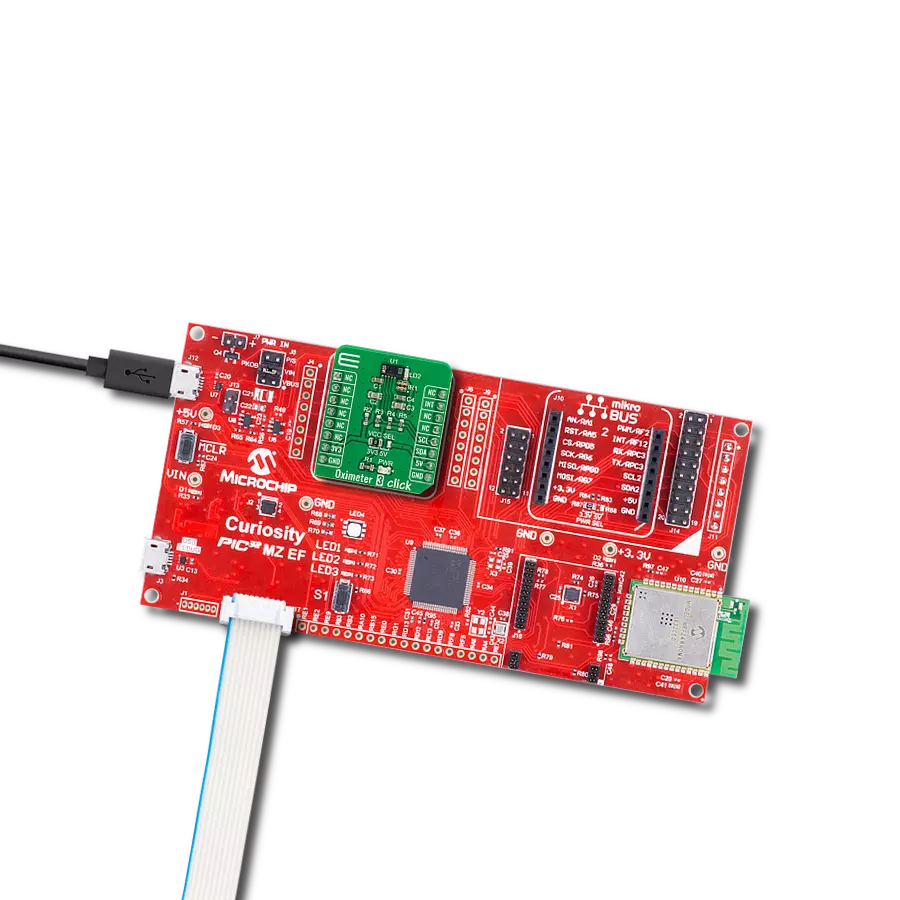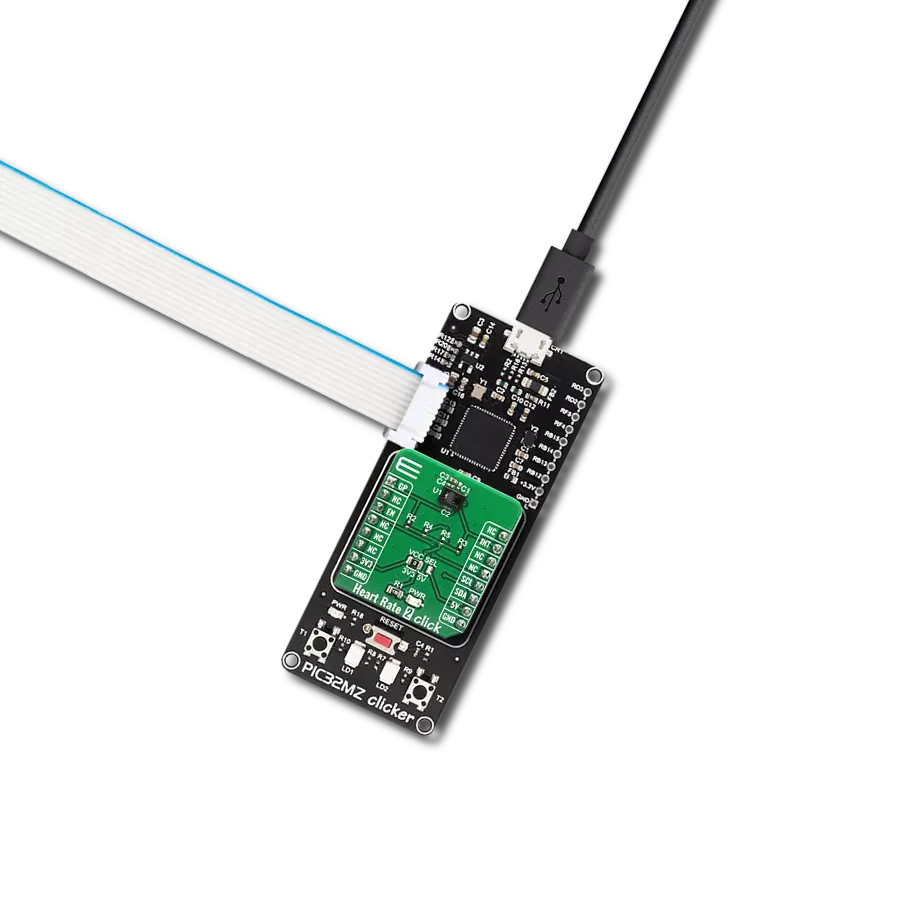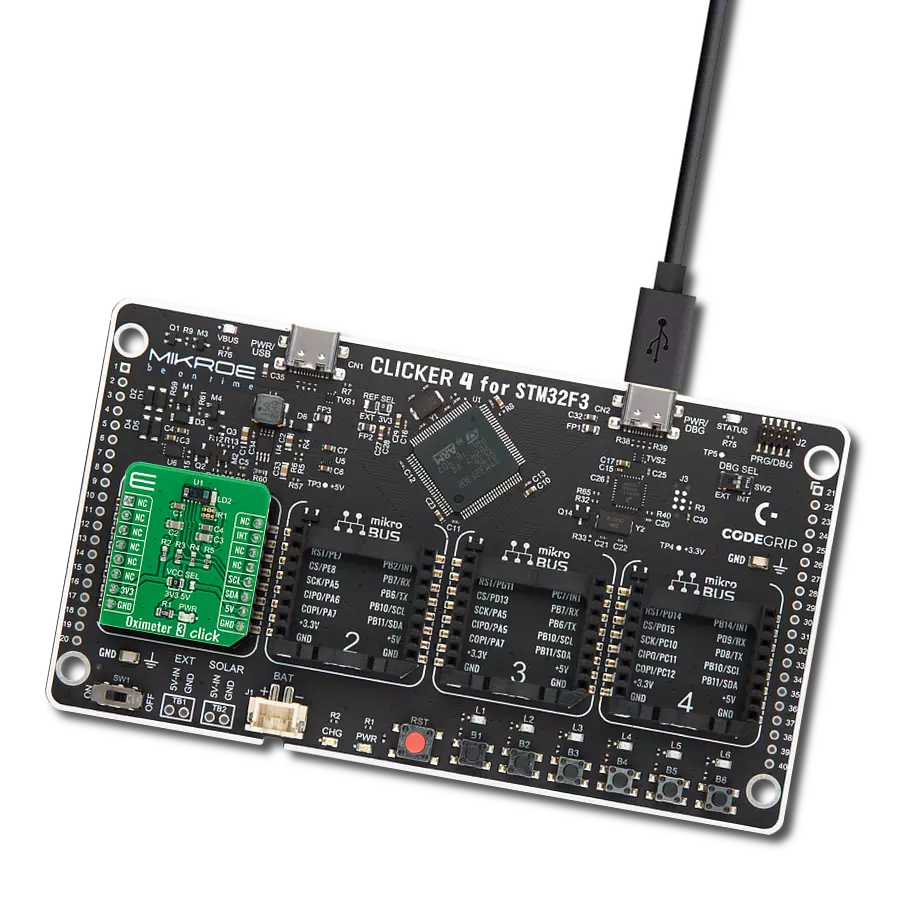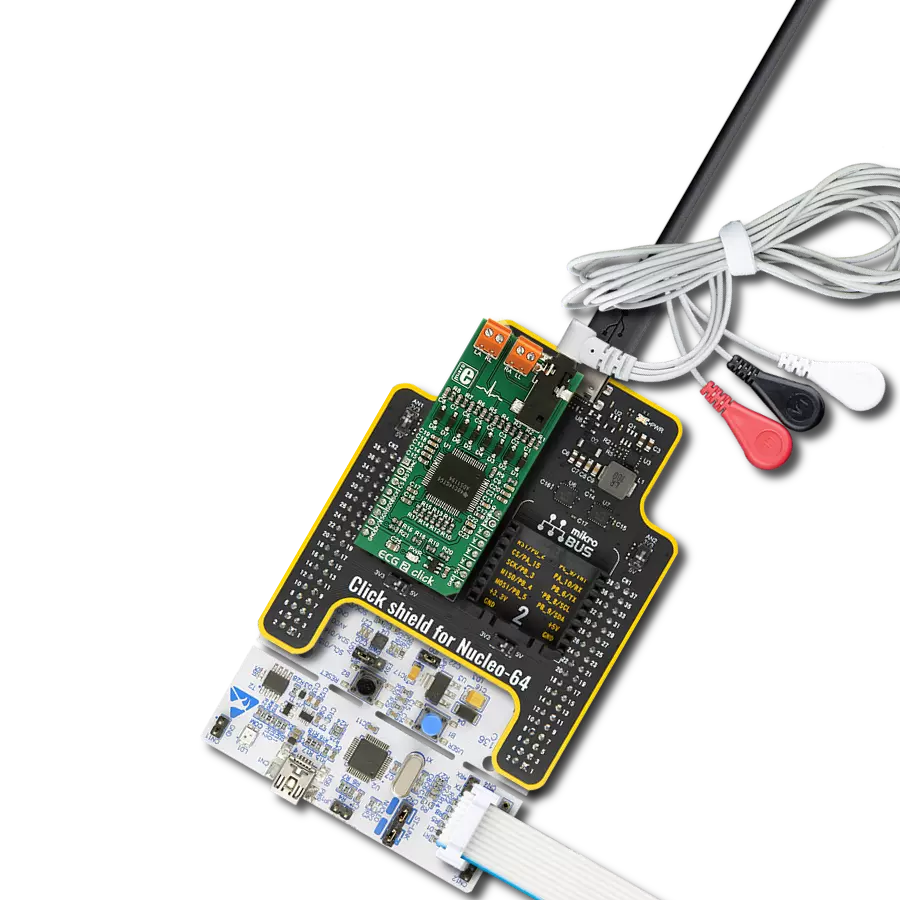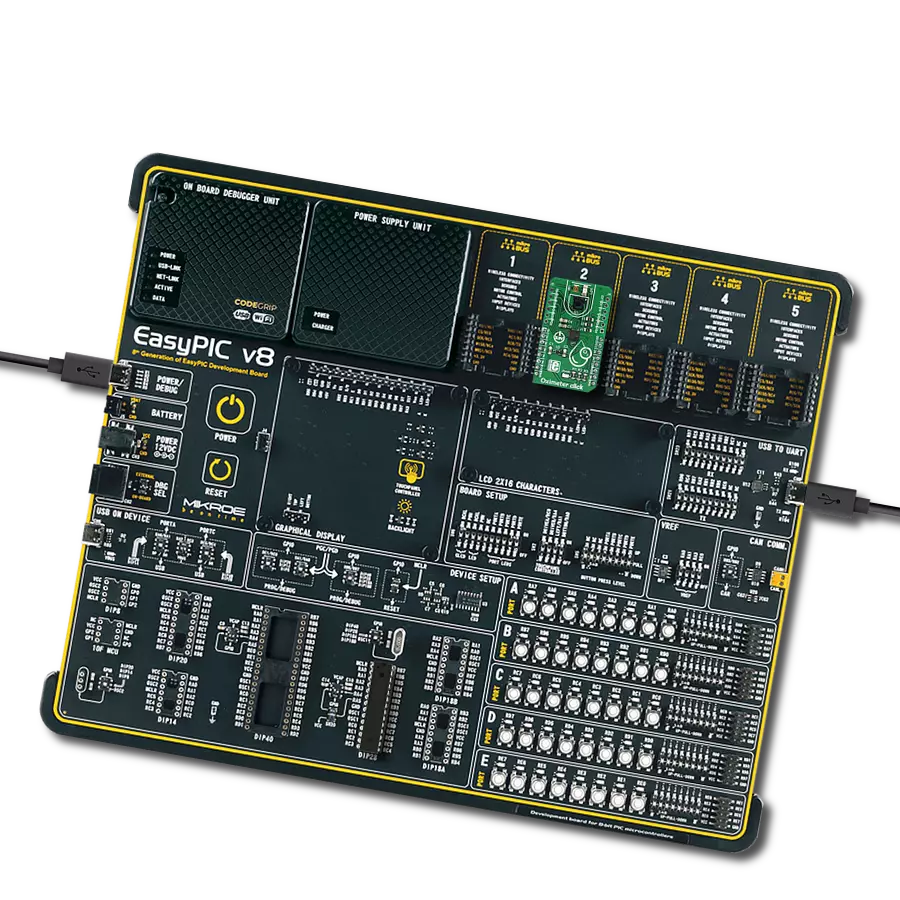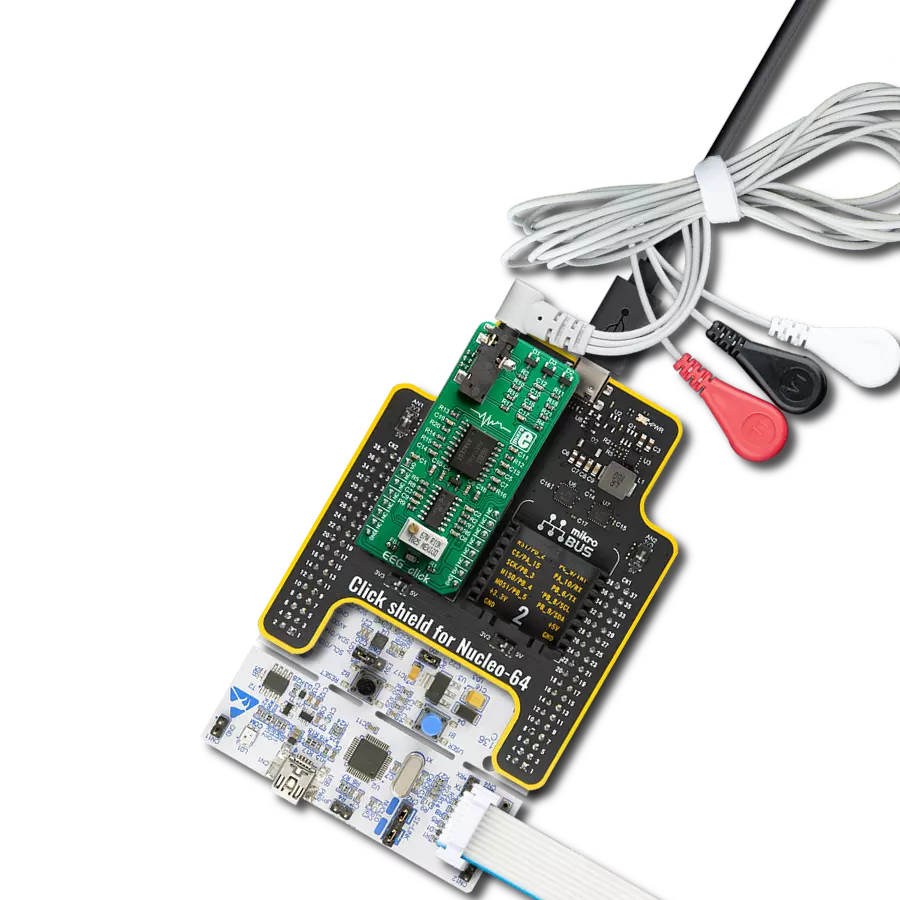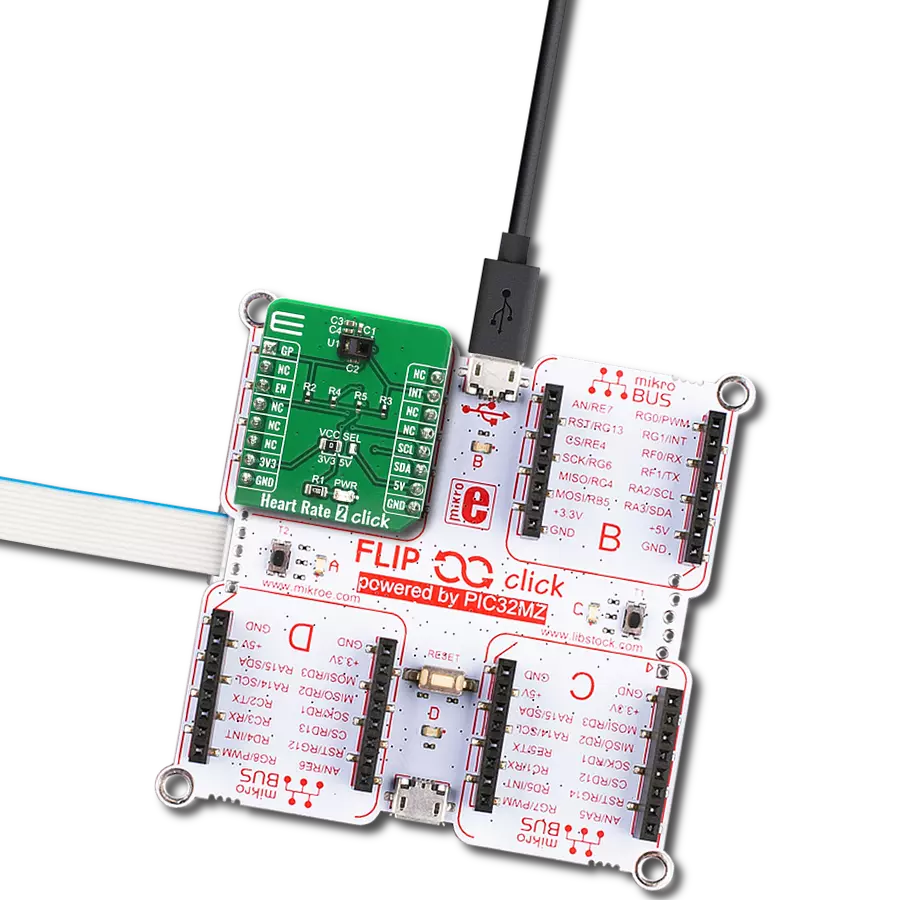Unlock the secrets of brainwaves with our cutting-edge EEG technology
A
A
Hardware Overview
How does it work?
EEG Click is based on the INA114, a precision instrumentation amplifier (IA) by Burr Brown®, a division of Texas Instruments specialized in high-performance analog and mixed-signal ICs. This IC offers low noise, LASER-trimmed offset voltage, and a good common-mode rejection ratio. It uses a single resistor to set up its gain, which can easily be set up to 10,000. On this Click board™, the INA114 IA has its gain set to about 12 times. Further, amplification and signal filtering is done by the MCP609, a four-channel op-amp from Microchip, so that the final gain factor is about 7800 times. Such high amplification is necessary to amplify faint voltages generated during brain activity. To fine-tune the amplification, a multi-turn precision potentiometer allows for setting the gain of the intermediate amplification stage between
10 and 100 times. Since the "brain waves " can be both positive and negative, EEG click uses a virtual GND at the potential of 2.048V. This also helps to reduce the noise from the common GND, improving the quality of the readings. The amplified brain activity signal is available at the AN pin of the mikroBUS™, allowing sampling by the host MCU. EEG measurements should be ideally conducted in an electrically isolated room since any electromagnetic interference (EMI) could corrupt the measurement data. However, the INA114 offers some EMI protection, as it features an outstanding common-mode rejection ratio (CMRR), allowing it to cancel out most of the induced interferences successfully. This Click board™ uses a 3-electrode setup, which can be connected over a 3.5mm Jack connector on the
Click board™. Although the best results can be achieved using silver-chlorine-plated electrodes, any electrode can be used. EEG uses the DRL electrode placement scheme: two electrodes are placed behind the ears, while the third is placed on the forehead. The DRL electrode (on the forehead) helps eliminate the common voltage, while two other electrodes are connected to the differential inputs of the INA114 IA. The complete signal path is very well protected against voltage spikes and transients that might appear as a result of the electrostatic discharge (ESD) in contact with the human body, so there is a set of ESD suppressing diodes and TVS diodes, which prevent sensitive IA and operational amplifiers on its output to become damaged by ESD events.
Features overview
Development board
Nucleo-64 with STM32F091RC MCU offers a cost-effective and adaptable platform for developers to explore new ideas and prototype their designs. This board harnesses the versatility of the STM32 microcontroller, enabling users to select the optimal balance of performance and power consumption for their projects. It accommodates the STM32 microcontroller in the LQFP64 package and includes essential components such as a user LED, which doubles as an ARDUINO® signal, alongside user and reset push-buttons, and a 32.768kHz crystal oscillator for precise timing operations. Designed with expansion and flexibility in mind, the Nucleo-64 board features an ARDUINO® Uno V3 expansion connector and ST morpho extension pin
headers, granting complete access to the STM32's I/Os for comprehensive project integration. Power supply options are adaptable, supporting ST-LINK USB VBUS or external power sources, ensuring adaptability in various development environments. The board also has an on-board ST-LINK debugger/programmer with USB re-enumeration capability, simplifying the programming and debugging process. Moreover, the board is designed to simplify advanced development with its external SMPS for efficient Vcore logic supply, support for USB Device full speed or USB SNK/UFP full speed, and built-in cryptographic features, enhancing both the power efficiency and security of projects. Additional connectivity is
provided through dedicated connectors for external SMPS experimentation, a USB connector for the ST-LINK, and a MIPI® debug connector, expanding the possibilities for hardware interfacing and experimentation. Developers will find extensive support through comprehensive free software libraries and examples, courtesy of the STM32Cube MCU Package. This, combined with compatibility with a wide array of Integrated Development Environments (IDEs), including IAR Embedded Workbench®, MDK-ARM, and STM32CubeIDE, ensures a smooth and efficient development experience, allowing users to fully leverage the capabilities of the Nucleo-64 board in their projects.
Microcontroller Overview
MCU Card / MCU

Architecture
ARM Cortex-M0
MCU Memory (KB)
256
Silicon Vendor
STMicroelectronics
Pin count
64
RAM (Bytes)
32768
You complete me!
Accessories
Click Shield for Nucleo-64 comes equipped with two proprietary mikroBUS™ sockets, allowing all the Click board™ devices to be interfaced with the STM32 Nucleo-64 board with no effort. This way, Mikroe allows its users to add any functionality from our ever-growing range of Click boards™, such as WiFi, GSM, GPS, Bluetooth, ZigBee, environmental sensors, LEDs, speech recognition, motor control, movement sensors, and many more. More than 1537 Click boards™, which can be stacked and integrated, are at your disposal. The STM32 Nucleo-64 boards are based on the microcontrollers in 64-pin packages, a 32-bit MCU with an ARM Cortex M4 processor operating at 84MHz, 512Kb Flash, and 96KB SRAM, divided into two regions where the top section represents the ST-Link/V2 debugger and programmer while the bottom section of the board is an actual development board. These boards are controlled and powered conveniently through a USB connection to program and efficiently debug the Nucleo-64 board out of the box, with an additional USB cable connected to the USB mini port on the board. Most of the STM32 microcontroller pins are brought to the IO pins on the left and right edge of the board, which are then connected to two existing mikroBUS™ sockets. This Click Shield also has several switches that perform functions such as selecting the logic levels of analog signals on mikroBUS™ sockets and selecting logic voltage levels of the mikroBUS™ sockets themselves. Besides, the user is offered the possibility of using any Click board™ with the help of existing bidirectional level-shifting voltage translators, regardless of whether the Click board™ operates at a 3.3V or 5V logic voltage level. Once you connect the STM32 Nucleo-64 board with our Click Shield for Nucleo-64, you can access hundreds of Click boards™, working with 3.3V or 5V logic voltage levels.
3-wire ECG/EMG cable comes with a convenient 3.5mm phone jack, and it is designed for electrocardiogram recording. This 1m cable is a practical companion for medical professionals and enthusiasts. To complement this cable, you can also use single-use adhesive ECG/EMG electrodes measuring 48x34mm, each equipped with an ECG/EMG cable stud adapter. These electrodes ensure a seamless experience when paired with our ECG/EMG cable and guarantee reliable ECG/EMG signal transmission for comprehensive cardiac monitoring. Trust in the accuracy and convenience of this setup to effortlessly record electrocardiograms and electromyograms with confidence.
Used MCU Pins
mikroBUS™ mapper
Take a closer look
Click board™ Schematic

Step by step
Project assembly
Software Support
Library Description
This library contains API for EEG Click driver.
Key functions:
eeg_read_an_pin_value- This function reads results of AD conversion of the AN pineeg_read_an_pin_voltage- This function reads results of AD conversion of the AN pin and converts them to proportional voltage level
Open Source
Code example
The complete application code and a ready-to-use project are available through the NECTO Studio Package Manager for direct installation in the NECTO Studio. The application code can also be found on the MIKROE GitHub account.
/*!
* @file main.c
* @brief EEG Click Example.
*
* # Description
* This example demonstrates the use of EEG Click board.
*
* The demo application is composed of two sections :
*
* ## Application Init
* Initializes Click board.
*
* ## Application Task
* Reads ADC value and sends results on serial plotter every 5 ms.
*
* @author Jelena Milosavljevic
*
*/
#include "board.h"
#include "log.h"
#include "eeg.h"
static eeg_t eeg; /**< EEG Click driver object. */
static log_t logger; /**< Logger object. */
uint32_t time = 0;
void application_init ( void )
{
log_cfg_t log_cfg; /**< Logger config object. */
eeg_cfg_t eeg_cfg; /**< Click config object. */
/**
* Logger initialization.
* Default baud rate: 115200
* Default log level: LOG_LEVEL_DEBUG
* @note If USB_UART_RX and USB_UART_TX
* are defined as HAL_PIN_NC, you will
* need to define them manually for log to work.
* See @b LOG_MAP_USB_UART macro definition for detailed explanation.
*/
LOG_MAP_USB_UART( log_cfg );
log_init( &logger, &log_cfg );
log_info( &logger, " Application Init " );
log_printf( &logger, " ----------------------------------------------\r\n" );
log_printf( &logger, " ***EEG Click*** \r\n" );
log_printf( &logger, "----------------------------------------------\r\n" );
Delay_ms ( 1000 );
Delay_ms ( 1000 );
// Click initialization.
eeg_cfg_setup( &eeg_cfg );
EEG_MAP_MIKROBUS( eeg_cfg, MIKROBUS_1 );
if ( ADC_ERROR == eeg_init( &eeg, &eeg_cfg ) ){
log_error( &logger, " Application Init Error. " );
log_info( &logger, " Please, run program again... " );
for ( ; ; );
}
log_info( &logger, " Application Task " );
}
void application_task ( void )
{
uint16_t eeg_an_value = 0;
if ( eeg_read_an_pin_value( &eeg, &eeg_an_value ) != ADC_ERROR ) {
log_printf( &logger, " %u,%lu\r\n", eeg_an_value, time );
Delay_ms ( 5 );
time += 5;
}
}
int main ( void )
{
/* Do not remove this line or clock might not be set correctly. */
#ifdef PREINIT_SUPPORTED
preinit();
#endif
application_init( );
for ( ; ; )
{
application_task( );
}
return 0;
}
// ------------------------------------------------------------------------ END
Additional Support
Resources
Category:Biometrics





















